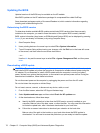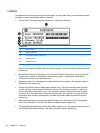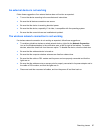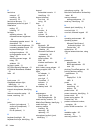
A Traveling with the computer
For best results, follow these traveling and shipping tips:
● Prepare the computer for traveling or shipping:
◦
Back up your information.
◦
Remove all discs and all external media cards, such as digital cards.
CAUTION: To reduce the risk of damage to the computer, damage to a drive, or loss of
information, remove the media from a drive before removing the drive from a drive bay and
before shipping, storing, or traveling with a drive.
◦
Turn off and then disconnect all external devices.
◦
Shut down the computer.
●
Take along a backup of your information. Keep the backup separate on the computer.
●
When traveling by air, carry the computer as hand luggage; do not check it in with the rest of
your bags.
CAUTION: Avoid exposing a drive to magnetic fields. Security devices with magnetic fields
include airport walk-through devices and security wands. Airport conveyer belts and similar
security devices that check carry-on baggage use X-rays instead of magnetism and do not
damage drives.
●
In-flight computer use is at the discretion of the airline. If you plan to use the computer during a
flight, check with the airline in advance.
●
If the computer will be unused and disconnected from external power for more than 2 weeks,
remove the battery and store it separately.
● If you are shipping the computer or a drive, use suitable protective packaging and label the
package “FRAGILE.”
● If the computer has a wireless device or an HP Mobile Broadband Module installed, such as an
802.11b/g device, a Global System for Mobile Communications (GSM) device, or a General
Packet Radio Service (GPRS) device, the use of these devices may be restricted in some
environments. Such restrictions may apply onboard aircraft, in hospitals, near explosives, and in
83


















